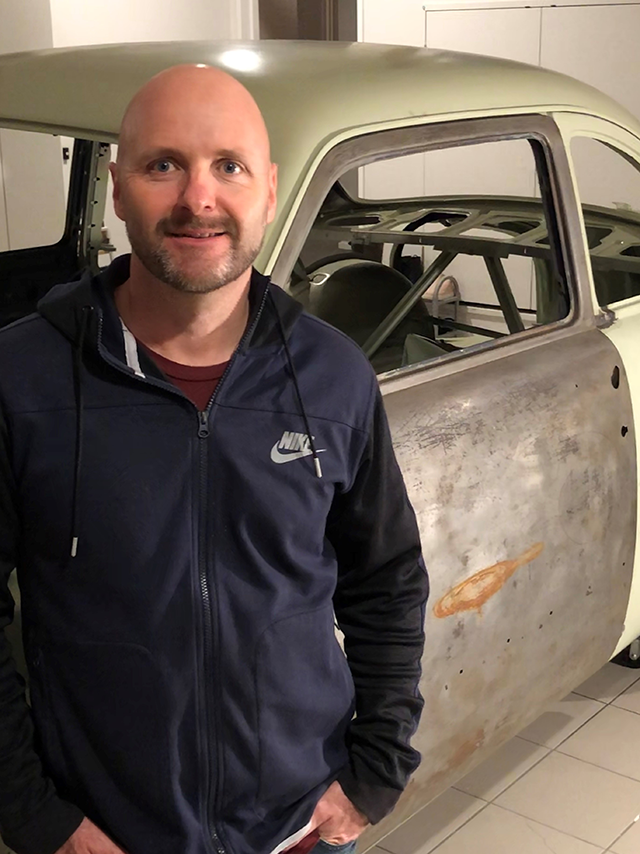At the young age of 43 last year, Andrew Smyth got diagnosed with psoriatic arthritis. The diagnosis hit him like a bolt of lightning. “I thought arthritis was what old people get. Surely 43 isn’t old enough, let alone 36, when my symptoms first started to appear”.
Looking back, Andrew says that the first symptoms appeared seven years earlier. It started as random things that didn’t seem linked to anything else – a swollen, painful toe, ridges in the fingernails and toenails, and pains in the wrists and knees.
“I’ve always been physically active, so I put a lot of these pains down to earlier BMX and skateboarding injuries.”
Then one Friday morning, he had a flare in his foot that came on suddenly. By midday, Andrew couldn’t put any weight on his right foot. He went to his GP, got referred to a rheumatologist, and got diagnosed.
Initially, the physical and mental adjustment was tough. Autoimmune diseases are life-changing, and plans can suddenly get thrown into disarray. “I became apprehensive about starting new challenges, plan, and even accept invitations – what would happen if I had another flare-up?”
However, life does carry on, he says. “I’ve learned a lot about myself and how to live a healthier lifestyle – both mentally and physically.”
How Andrew manages psoriatic arthritis
Andrew consulted a dietician who also has arthritis, and started an autoimmune ‘elimination diet.’ He says it was tough at the start, but the results have been amazing.

Initially, he eliminated several foods from his diet and then gradually reintroduced them to see which ones would induce a flare-up. “Foods that you’d assume would be healthy for you, could be causing a negative response in your body. And everyone is a bit different”.
With this new diet, Andrew experiences a lot less fatigue, which is a typical autoimmune disease symptom. What were initially constant pain and regular massive flare-ups have become more manageable. Flare-ups only come on when he’s under particular stress or tries to reintroduce a food that doesn’t agree with his body.
“I have also engaged with some holistic therapies (that I previously may have scoffed at) including kinesiology, acupuncture, and traditional Eastern Medicine (herbal tonics). I’ve found these “alternative” therapies incredibly beneficial.”
After diagnosis, Andrew stopped heavy exercise, but recently returned to the gym and said it’s been fantastic both physically and mentally.
“Throughout all of this, I have continued to work a full-time physical job, which keeps me motivated and engaged, and I am a dad to three amazing, energetic kids. My journey with this hasn’t finished. I know there will be more challenges along the way, but I’ll continue to work with my squad of docs, specialists, and dieticians. And with the support from my partner, friends, and family, I know I will push through and continue to lead a full, rewarding life”.
Andrew has also taken to Instagram (@autoimmuneinaotearoa) to share what works for him, what doesn’t, and everything in between, particularly in terms of diet, in the hope he can help other people.
My one parting thought, if I could go back and give a message to myself from one year ago, I’d say: Hang in there. It’s not all doom and gloom. You’ll learn how to manage this. Keep an open mind and stay positive”.
What is psoriatic arthritis?
Psoriatic arthritis combines the painful, swollen joints of arthritis with the skin disease psoriasis that causes itchy red scaly patches on the skin and pitted thickened nails.
Between 10% and 30% of those who have the skin disease will also develop psoriatic arthritis, which can range from mild to severe and affect one or more joints. Sometimes, joints problems appear before the skin condition, while other people with arthritic symptoms never develop psoriasis.
Men and women are equally affected by psoriatic arthritis, which usually appears during adulthood. The condition varies from person to person, and can easily be mistaken for other forms of arthritis.
The symptoms usually start slowly. Joint tissue becomes inflamed, leading to pain, swelling, and stiffness. Over time, the muscles and ligaments around the bone, the cartilage and the bones themselves become damaged, which can lead to joint deformities.
What is the cost of arthritis in New Zealand?
Medical costs for arthritis amounted to $1 billion in 2018. Of that, a third were in-hospital expenses (public and private). A staggering 48% of people with arthritis are of working age, people with families and responsibilities, people trying to make a life for themselves.
The findings in the recent Economic Cost of Arthritis in New Zealand report have significant implications for how the health system manages arthritis. Some key findings related to health care costs:
- Health sector costs related to arthritis were estimated to be $992.5 million in 2018, equivalent to 23% of total financial costs.
- Of this, an estimated one third is attributable to hospital inpatient costs ($321.0 million). Public inpatient costs were estimated to be $244.0 million, and private inpatient costs were estimated to be significantly lower, at $77.0 million.
- Residential aged cared costs related to arthritis were estimated to be $97.9 million, while arthritis-related pathology and diagnostic imaging costs were estimated to be $96.4 million, and pharmaceuticals costs were estimated to be $69.5 million.
Arthritis can affect anyone at any age, and new figures released in 2018 reveal that more than 670,000 people in New Zealand have a form of arthritis (osteoarthritis, gout, rheumatoid arthritis, lupus and more than 140 other types), 48% of which are of working age.
Help us keep sharing stories!
We are a charity that relies on community funding. Help us to keep finding and sharing stories from people with arthritis by making a donation today!